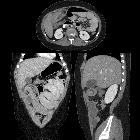Burkitt lymphoma













Burkitt lymphoma is an aggressive B-cell lymphoma predominantly affecting children.
Epidemiology
Burkitt lymphoma is the most common (40%) type of non-Hodgkin lymphoma in childhood. Median age is eight years with a male predominance (M:F = 4:1) . It is less common in adults, accounting for 1-2% of lymphomas .
It is considered endemic in parts of Africa where rates are up to 50 times higher than in the USA. Cases occur sporadically outside of the tropics.
Risk factors
- HIV/AIDS
- post-transplant immunosuppression
Clinical presentation
Burkitt lymphoma affects many organs, and this affects presentation. Extranodal involvement is common (~30%) at presentation, most often presenting as an abdominal or pelvic mass. Most patients present with widespread disease.
Pathology
Three forms of Burkitt lymphoma have been described :
- endemic Burkitt lymphoma: linked to Epstein-Barr virus (EBV) and Plasmodium falciparum malaria infections
- sporadic Burkitt lymphoma: etiology unknown
- immunodeficiency-associated Burkitt lymphoma: occurs in patients with HIV, post-transplant or congenital immunosuppression
Burkitt lymphoma is an aggressive tumor with a doubling time of 24 hours. It can present in a wide variety of locations:
- head and neck, e.g. facial bones, Waldeyer ring
- pleural space (~70%)
- gastrointestinal tract, especially the ileocecal region
- mesentery, peritoneum, retroperitoneum
- kidneys
- gonads (~75%)
Nodal involvement is more common in adults than in children .
Radiographic features
Radiographic features vary widely depending on organ involvement:
- abdominal manifestations of Burkitt lymphoma
- musculoskeletal manifestations of Burkitt lymphoma
- head and neck manifestations of Burkitt lymphoma
Treatment and prognosis
Burkitt lymphoma can be treated with chemotherapy. In children, the prognosis is good with survival rates >90%. In adults, the prognosis is poorer, with a 5-year survival rate of ~50% and is even worse with bone marrow or CNS involvement (>30% 5-year survival rate) .
History and etymology
First described by Denis Parsons Burkitt (1911-1993), an Irish surgeon, in 1958 in Uganda, Africa .
Differential diagnosis
- other forms of high-grade B-cell lymphoma
- Crohn disease may mimic Burkitt lymphoma on ultrasound, barium studies, and CT
Siehe auch:
- Lymphom
- Lymphom des Gastrointestinaltraktes
- primäres Lymphom des Knochens
- Burkitt-Lymphom des Magens
- B-Zell-Non-Hodgkin-Lymphome
- endemisches Burkitt-Lymphom
- HIV-assoziiertes Burkitt-Lymphom
- sporadisches Burkitt-Lymphom
und weiter:

 Assoziationen und Differentialdiagnosen zu Burkitt-Lymphom:
Assoziationen und Differentialdiagnosen zu Burkitt-Lymphom:


